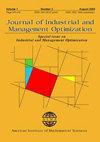具有仿射扩散因子过程和HARA偏好的资产负债管理最优投资策略
IF 1.6
4区 工程技术
Q3 ENGINEERING, MULTIDISCIPLINARY
引用次数: 3
摘要
本文研究了期望效用最大化框架下的最优资产负债管理问题。采用一般双曲绝对风险厌恶(HARA)效用来描述资产负债管理者的风险偏好。金融市场分为无风险资产和风险资产。风险的市场价格取决于一个仿射扩散因子过程,该过程包括但不限于恒定弹性方差(CEV), Stein-Stein, Schöbel和Zhu, Heston, 3/2, 4/2模型以及一些非马尔可夫模型,作为例外。累积负债过程具有广义漂移布朗运动的特征,可能具有无界和非马尔可夫漂移和扩散系数。由于HARA效用的复杂结构和不完全金融市场的非马尔可夫框架,本文采用倒向随机微分方程(BSDE)方法。通过求解递归耦合BSDE系统,导出了最优投资策略和最优价值函数的封闭表达式。此外,对模型的一些特殊情况给出了显式解。最后,通过数值算例说明了模型参数对最优投资策略的影响。本文章由计算机程序翻译,如有差异,请以英文原文为准。
Optimal investment strategies for asset-liability management with affine diffusion factor processes and HARA preferences
This paper investigates an optimal asset-liability management problem within the expected utility maximization framework. The general hyperbolic absolute risk aversion (HARA) utility is adopted to describe the risk preference of the asset-liability manager. The financial market comprises a risk-free asset and a risky asset. The market price of risk depends on an affine diffusion factor process, which includes, but is not limited to, the constant elasticity of variance (CEV), Stein-Stein, Schöbel and Zhu, Heston, 3/2, 4/2 models, and some non-Markovian models, as exceptional examples. The accumulative liability process is featured by a generalized drifted Brownian motion with possibly unbounded and non-Markovian drift and diffusion coefficients. Due to the sophisticated structure of HARA utility and the non-Markovian framework of the incomplete financial market, a backward stochastic differential equation (BSDE) approach is adopted. By solving a recursively coupled BSDE system, closed-form expressions for both the optimal investment strategy and optimal value function are derived. Moreover, explicit solutions to some particular cases of our model are provided. Finally, numerical examples are presented to illustrate the effect of model parameters on the optimal investment strategies in several particular cases.
求助全文
通过发布文献求助,成功后即可免费获取论文全文。
去求助
来源期刊
CiteScore
2.50
自引率
15.40%
发文量
207
审稿时长
18 months
期刊介绍:
JIMO is an international journal devoted to publishing peer-reviewed, high quality, original papers on the non-trivial interplay between numerical optimization methods and practically significant problems in industry or management so as to achieve superior design, planning and/or operation. Its objective is to promote collaboration between optimization specialists, industrial practitioners and management scientists so that important practical industrial and management problems can be addressed by the use of appropriate, recent advanced optimization techniques.

 求助内容:
求助内容: 应助结果提醒方式:
应助结果提醒方式:


